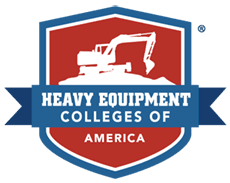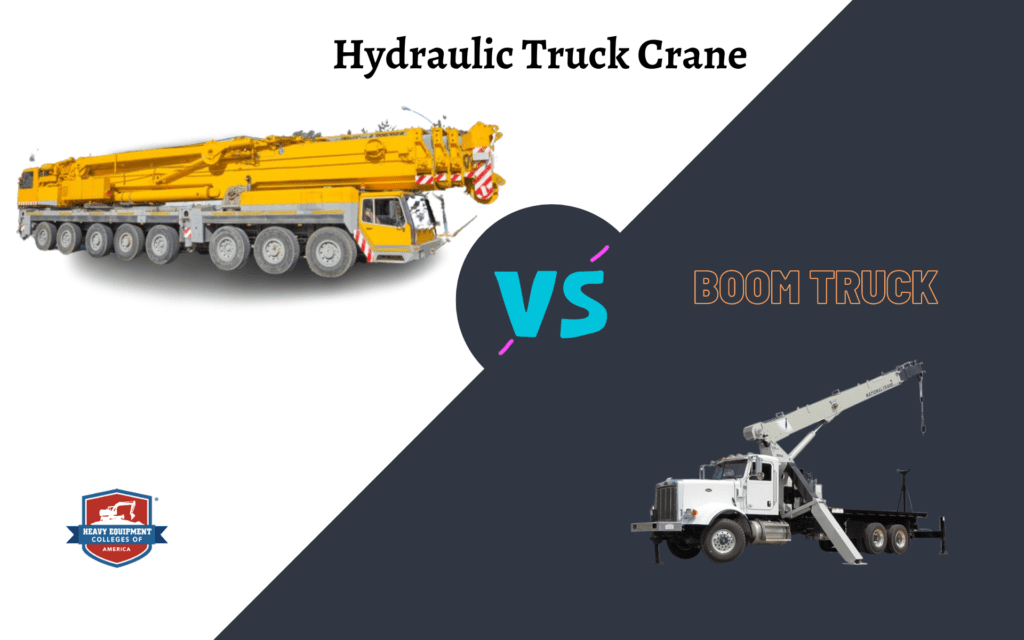Have you ever wondered what the difference is between a hydraulic truck crane and a boom truck? As your trusted crane experts, we’re here to teach you the benefits of each and help you choose which option is best for your intended applications. Let’s dive into what these cranes are, how they work, and what their intended uses are so you can make an informed decision.
Table of Contents
Hydraulic Truck Crane vs. Boom Truck
What Is a Hydraulic Truck Crane?
A hydraulic truck crane uses hydraulic mechanisms to lift heavy objects. It consists of the following parts:
- Enclosed operator cab
- Steel base
- Telescopic boom
- Jib or pulley
- Outriggers
- Counterweights
- Load movement indicator
- Rotex gear
- Two-gear pump
Hydraulic truck cranes are often used on construction sites for airports, bridges, railways, roads, stadiums, hotels, apartment complexes, and malls. They’re stable and can lift extreme weights. The load capacity varies based on its weight. The heavier the crane, the higher the load capacity, and vice versa. Here are some basic load capacities.
- 75-ton crane: 10,800 pounds
- 90-ton crane: 11,500 pounds
- 100-ton crane: 32,500 pounds
In addition to having a high load capacity, hydraulic truck cranes feature these benefits.
- They’re user-friendly and easy to maintain
- They’re lightweight compared to larger and less powerful cranes
- They’re flexible and versatile
- They’re more compact compared to stationary cranes
Get Crane Operator Training at HEC
The History of Cranes: Things You Need to Know
Keep reading to learn about the history of cranes, various crane types, and crane safety.
Read More!How Does a Hydraulic Truck Crane Work?
Hydraulic truck cranes use pressurized fluids—typically oil—and a pump system to create the lifting power required to raise and lower heavy loads. These cranes use one of two types of pumps.
- Gear pumps: Most hydraulic truck cranes use gear pumps. They contain interlocking gears that move the oil while the engine accelerates. When the engine runs at full capacity, the pressure maximizes.
- Variable-displacement pumps: These pumps use advanced piston cylinders that are attached to a ring in a barrel that’s attached to a swashplate. The barrel spins while the swashplate pushes the pistons in the cylinder and pulls them out of it to create pressure.
What Jobs Are Hydraulic Truck Cranes Good For?
Since hydraulic truck cranes have a high load capacity, they’re ideal for heavy-duty construction jobs. They’re durable enough to lift concrete blocks, bricks, and metal frames. They can also move objects like shipping containers, vehicles, and large animals during transport. Hydraulic truck cranes are surprisingly easy to use and maintain, partially because they’re more compact than other crane types, so they can be easier to maneuver.
Difference Between Mobile Cranes and Tower Cranes
Mobile Cranes vs Tower Cranes
Cranes are an essential part of construction projects that require hoisting heavy material and moving it around the area. Read on to explore all the differences between Mobile cranes versus Tower cranes.
Read More!What Is a Boom Truck?
A boom truck consists of a hydraulic crane attached to a commercial vehicle. Various types of trucks can be considered a boom truck. While its load capacity is less than that of a hydraulic truck crane, its mobility and versatility are greater. These cranes can travel along public roads at a consistent speed, making it easy to transport materials between locations.
There are two types of boom trucks.
- Fixed cab: The cab on a fixed cab crane is stationary and doesn’t rotate.
- Swing cab: The cab on a swing cab crane is mobile and can rotate up to 360 degrees.
A boom truck consists of the following components:
- Winch
- Flatbed
- Boom
- Boom cylinder
- Boom head
- Hook
- Outriggers
Boom trucks can reach heights of up to 160 to 180 feet. They also deliver precise movements.
How Does a Boom Truck Work?
The boom extends and contracts via the boom cylinder to reach the designated height. The cab, which is often a flatbed truck, contains controls the operator uses to move both the vehicle and the crane. The retractable outrigger helps stabilize the truck and keep it stationary while materials are being lifted.
What Jobs Are Boom Trucks Good For?
Boom trucks are used primarily to construct roads, buildings, and other essential structures. Utility companies often use them to install, check, and take down power lines. HVAC companies even use them to lift heating and cooling units. Since boom trucks have a smaller load capacity than hydraulic truck cranes, they’re ideal for jobs involving loads weighing 54 tons or less.
Hydraulic Truck Crane vs. Boom Truck: Which Is Better for Your Project?
When it comes down to choosing between a hydraulic truck crane and a boom truck for your application, there are a few factors to consider. First, let’s start with the functions and features they share. Both provide essential lifting power on construction sites. Both are versatile and can be used for various applications.
Now, let’s take a look at the advantages each one offers.
Hydraulic Truck Cranes
- They’re better for lifting loads weighing greater than 54 tons
- They’re ideal for job sites with rough terrain
- They’re extremely durable and compact
Boom Trucks
- They’re better for lifting loads weighing less than 54 tons
- They’re ideal for job sites with smooth terrain
- They’re extremely mobile
Here are some questions you should ask when determining which one is better for you:
- What type of loads do you plan to lift, and how heavy are they?
- What is the terrain like on your job site?
- What radius is needed for the lift?
- How high does the load need to reach?
- Will you need to move the crane between locations?
Become a Certified Crane Operator
Are you ready to take the first step in your heavy equipment career? Enroll in a crane training program at Heavy Equipment Colleges of America (HEC). Whatever type of crane you want to learn how to operate, we have a program for you. All of our crane training programs can be completed in as little as three weeks so you can get to work as soon as possible. Click on your desired program to learn more.
Find a Crane Training School in Your Area
Don’t wait for the future you want. Enroll in a program today at an HEC crane training school near you. With locations in California, Georgia, and Oklahoma, you may find a program that works with your schedule. Contact our team today to start the enrollment process.





